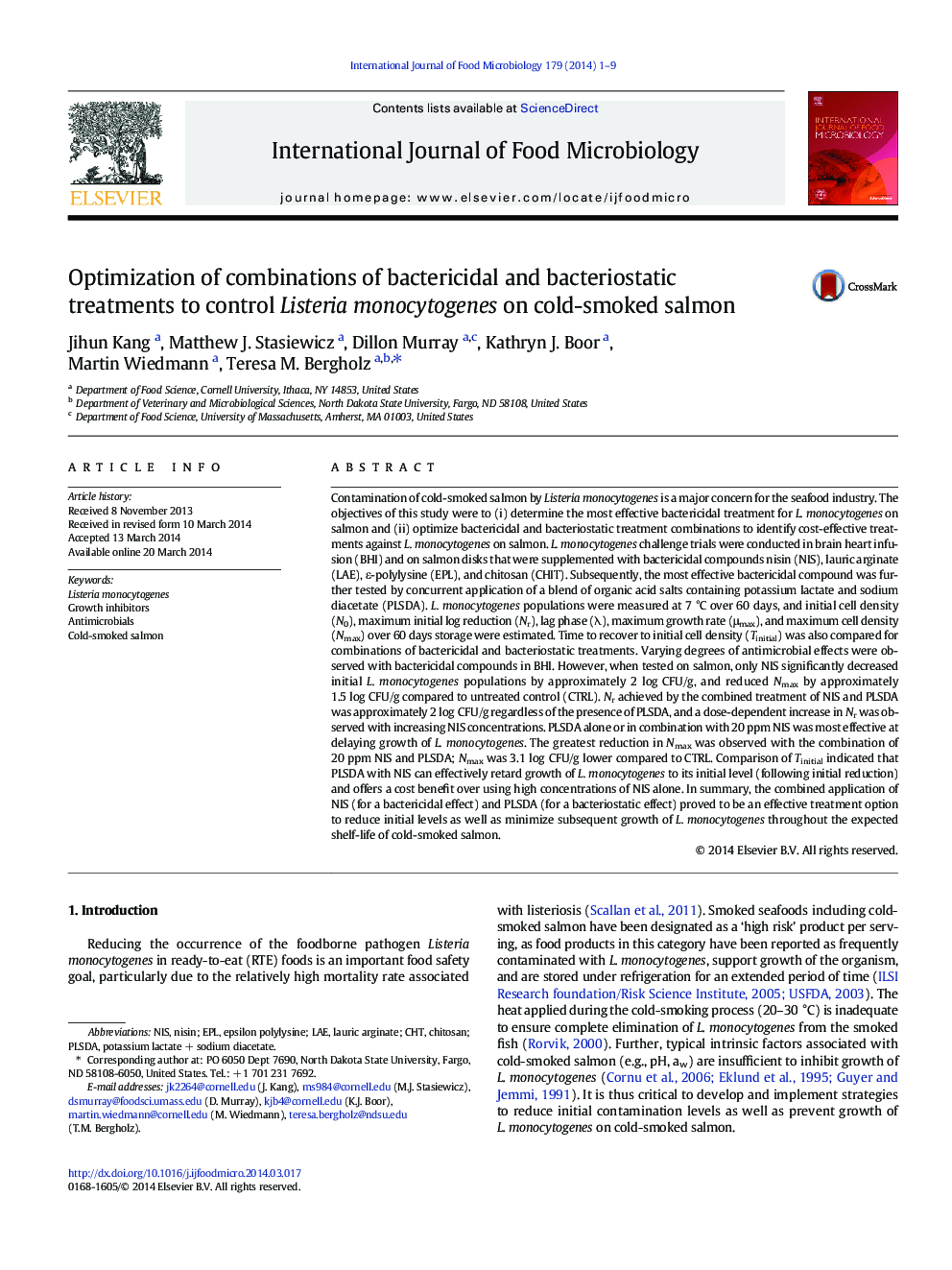| کد مقاله | کد نشریه | سال انتشار | مقاله انگلیسی | نسخه تمام متن |
|---|---|---|---|---|
| 6290088 | 1616603 | 2014 | 9 صفحه PDF | دانلود رایگان |
عنوان انگلیسی مقاله ISI
Optimization of combinations of bactericidal and bacteriostatic treatments to control Listeria monocytogenes on cold-smoked salmon
دانلود مقاله + سفارش ترجمه
دانلود مقاله ISI انگلیسی
رایگان برای ایرانیان
کلمات کلیدی
موضوعات مرتبط
علوم زیستی و بیوفناوری
علوم کشاورزی و بیولوژیک
دانش تغذیه
پیش نمایش صفحه اول مقاله

چکیده انگلیسی
Contamination of cold-smoked salmon by Listeria monocytogenes is a major concern for the seafood industry. The objectives of this study were to (i) determine the most effective bactericidal treatment for L. monocytogenes on salmon and (ii) optimize bactericidal and bacteriostatic treatment combinations to identify cost-effective treatments against L. monocytogenes on salmon. L. monocytogenes challenge trials were conducted in brain heart infusion (BHI) and on salmon disks that were supplemented with bactericidal compounds nisin (NIS), lauric arginate (LAE), ε-polylysine (EPL), and chitosan (CHIT). Subsequently, the most effective bactericidal compound was further tested by concurrent application of a blend of organic acid salts containing potassium lactate and sodium diacetate (PLSDA). L. monocytogenes populations were measured at 7 °C over 60 days, and initial cell density (N0), maximum initial log reduction (Nr), lag phase (λ), maximum growth rate (μmax), and maximum cell density (Nmax) over 60 days storage were estimated. Time to recover to initial cell density (Tinitial) was also compared for combinations of bactericidal and bacteriostatic treatments. Varying degrees of antimicrobial effects were observed with bactericidal compounds in BHI. However, when tested on salmon, only NIS significantly decreased initial L. monocytogenes populations by approximately 2 log CFU/g, and reduced Nmax by approximately 1.5 log CFU/g compared to untreated control (CTRL). Nr achieved by the combined treatment of NIS and PLSDA was approximately 2 log CFU/g regardless of the presence of PLSDA, and a dose-dependent increase in Nr was observed with increasing NIS concentrations. PLSDA alone or in combination with 20 ppm NIS was most effective at delaying growth of L. monocytogenes. The greatest reduction in Nmax was observed with the combination of 20 ppm NIS and PLSDA; Nmax was 3.1 log CFU/g lower compared to CTRL. Comparison of Tinitial indicated that PLSDA with NIS can effectively retard growth of L. monocytogenes to its initial level (following initial reduction) and offers a cost benefit over using high concentrations of NIS alone. In summary, the combined application of NIS (for a bactericidal effect) and PLSDA (for a bacteriostatic effect) proved to be an effective treatment option to reduce initial levels as well as minimize subsequent growth of L. monocytogenes throughout the expected shelf-life of cold-smoked salmon.
ناشر
Database: Elsevier - ScienceDirect (ساینس دایرکت)
Journal: International Journal of Food Microbiology - Volume 179, 2 June 2014, Pages 1-9
Journal: International Journal of Food Microbiology - Volume 179, 2 June 2014, Pages 1-9
نویسندگان
Jihun Kang, Matthew J. Stasiewicz, Dillon Murray, Kathryn J. Boor, Martin Wiedmann, Teresa M. Bergholz,